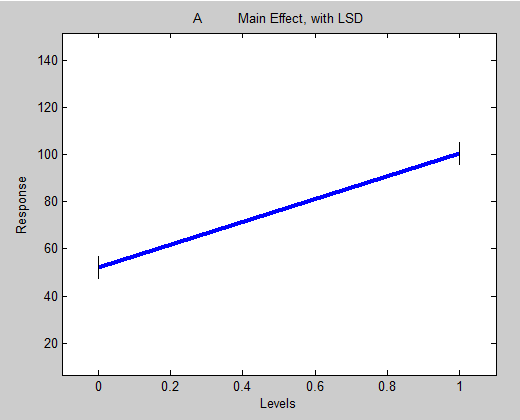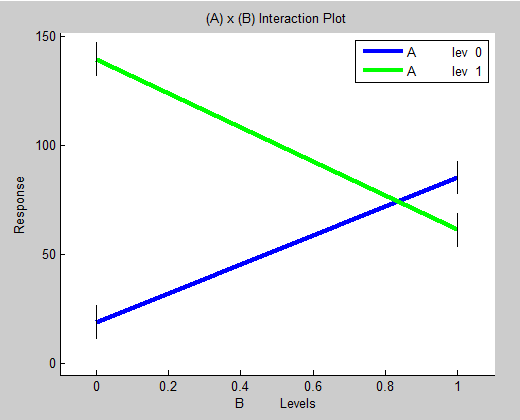Effects Plot: Difference between revisions
imported>Donal No edit summary |
imported>Donal No edit summary |
||
| Line 11: | Line 11: | ||
===Interpretation=== | ===Interpretation=== | ||
Main Effects plots show how the mean response of a factor varies over its level. The levels of this factor are marked on the x-axis. Data points are plotted with y-value giving the mean for the factor at that factor level. | Main Effects plots show how the mean response of a factor varies over its level. The levels of this factor are marked on the x-axis. Data points are plotted with y-value giving the mean for the factor at that factor level. This figure shows the main effect of factor A, showing the mean response increases with factor A. | ||
[[Image:Maineffectplot_fA.png]] | [[Image:Maineffectplot_fA.png]] | ||
An interaction effect refers to the effect of a second factor on the main effect of a first factor. | An interaction effect refers to the effect of a second factor on the main effect of a first factor. The interaction of factor A and factor B can be presented by showing the main effect of factor A for each level of factor B. If factor B has two levels then there will be two lines plotted, one showing the main effect of factor A when only considering experiments where factor B level is low, and one showing the main effect of factor A when only considering experiments where factor B is high. An interaction effect is significant if there is a change in the main effect of one variable over levels of the second. The figure below shows that there is a significant interaction between factors A and B. The blue line shows the mean response increases with factor A level when factor B level is low but that the response decreases with factor A level when factor B level is high. | ||
The effects plots may also show 'error bars' about each plotted point. These represent Fisher's Least Difference. | |||
[[Image:Maineffectplot_fAxB.png]] | [[Image:Maineffectplot_fAxB.png]] | ||
Revision as of 16:20, 9 November 2011
The following describes the Effects Plot for analyzing Design of Experiments results with MLR.
Effects Plot
Usage
Effects plots are used to identify which experiment factors are important, including interactions. Clicking on the 'DOE Effects Plot' menu button will open a window where you select which main effect or interaction effect you wish to view. Selecting an effect and clicking 'OK' opens the Effects Plot.
Interpretation
Main Effects plots show how the mean response of a factor varies over its level. The levels of this factor are marked on the x-axis. Data points are plotted with y-value giving the mean for the factor at that factor level. This figure shows the main effect of factor A, showing the mean response increases with factor A.
An interaction effect refers to the effect of a second factor on the main effect of a first factor. The interaction of factor A and factor B can be presented by showing the main effect of factor A for each level of factor B. If factor B has two levels then there will be two lines plotted, one showing the main effect of factor A when only considering experiments where factor B level is low, and one showing the main effect of factor A when only considering experiments where factor B is high. An interaction effect is significant if there is a change in the main effect of one variable over levels of the second. The figure below shows that there is a significant interaction between factors A and B. The blue line shows the mean response increases with factor A level when factor B level is low but that the response decreases with factor A level when factor B level is high.
The effects plots may also show 'error bars' about each plotted point. These represent Fisher's Least Difference.

